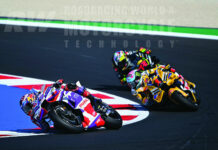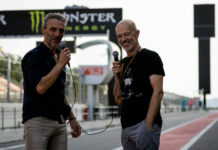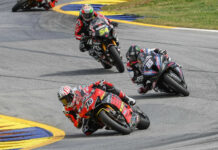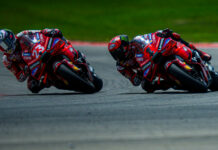From a press release issued by Yamaha:
MotoGP Set-up report – Welkom
Round: 2, South African MotoGP
April 27, 2003
Circuit: Phakisa Freeway, Welkom
Country: South Africa
Track length: 4242 m
Opened: 1999
Fastest Lap Ever: 1′ 34.629 (Valentino Rossi, 2001 – MotoGP)
MotoGP lap record: 1′ 34.834 (Tohru Ukawa, 2002)
Last year MotoGP winner: Tohru Ukawa
GP250 lap record: 1′ 36.828 (Marco Melandri, 2001)
Last year GP250 winner: Marco Melandri
Circuit tel: +27 57 3918000
Circuit web site: http://www.phakisa.com
2002 MotoGP race summary
Carlos Checa put in a determined ride during the 2002 South African MotoGP to finish the 28-lap race in the top five. Up until the closing stages the Spaniard held a solid grasp on fourth place when 2001 MotoGP 250 World Champion Daijiro Kato (Honda) made a late charge to dive through on the penultimate lap. It was a solid result that could have slipped through the Spaniards fingers before the race even began after he stalled the YZR-M1 on the warm-up lap and was forced to push-start the four-stoke machine. He eventually made it to his allotted seventh place on the grid moments before the start.
The race looked set to produce a second consecutive Valentino Rossi (Honda) victory after both he and Tohru Ukawa (Honda) broke away from the rest of the MotoGP field. Only Loris Capirossi (Honda) – who finished the day third on the first two-stroke machine – was able to keep the two four-strokes in sight. Then, at two-thirds race distance, Ukawa made his first attempt on the race lead, which he took successfully and held until Rossi fought back on lap 26. An unexpected mistake by the defending MotoGP world champ opened the door for Ukawa. The Japanese took advantage of the rare situation only to be attacked by the Italian on two more occasions. But as before Rossi wasn’t able to make the moves stick and Ukawa was left to take his first MotoGP race win.
Olivier Jacque (Yamaha) attempted to follow Kato’s move on the final lap, but couldn’t find a way by Checa’s YZR-M1 and was forced to settle for sixth place. Even so the Frenchman was more than happy with the result, as hot on his tail was the ever persistent Norick Abe (Yamaha), with eighth placed Shinya Nakano (Yamaha), in turn, all over his back wheel.
YZR-M1 Set-up Report
Over the past five years the Phakisa circuit has developed a notorious reputation for being both bumpy and slippery – the latter a side effect of the area’s flat and dusty surroundings. Combined, these two elements make setting up a 210 plus horsepower MotoGP machine uniquely difficult. Therefore the key to a successful result at this isolated venue is not outright horsepower, or an overly aggressive chassis geometry; rather a place on the podium hinges on a predictable power curve and a balanced, yet receptive suspension package.
With strong winds a regular occurrence in the region, along with rather dry conditions and irregular circuit use, it is common that a heavy film of grit is usually covering the track surface upon the arrival of the MotoGP spectacle. This factor alone makes finding the perfect race day set-up difficult, with the track conditions constantly changing as the round progresses. During the three days of the race weekend the circuit tends to offer more grip as a cleaner racing line begins to appear, often resulting in faster lap times – the beginning of an endless cycle of chasing chassis settings to suit the increasing pace.
With this in mind each rider is likely to opt for a chassis set-up that is initially plusher than would usually be expected for such a medium to high speed layout, in an effort to increase predictability and feel. A combination of balancing the YZR-M1’s rear ride-height, reducing compression damping and increasing the spring preload will reduce the likelihood of the bike’s rear suspension unit squatting under power – otherwise there is the risk of understeer during the exit of corners. At the same time this more forgiving set-up will also reduce excessive overload on the sidewall of the tyres over sharp and unpredictable surfaces; in turn making the bike behave more predictably. However as the times drop, with the increasing presence of a cleaner racing line, the cornering forces will build and will therefore require the need for increased spring weights along with firmer compression damping.
Improving the overall balance and feel further for Yamaha riders Carlos Checa (Fortuna Yamaha Team) and Alex Barros (Gauloises Yamaha Team) will be the availability of a further evolution of the M1’s Deltabox frame, which was first sampled by Checa in Suzuka following the opening round of the MotoGP World Championship. Initial results indicate that the latest incarnation offers improved rear wheel traction, increased predictability and greater braking stability, although further evaluations are needed. For this reason both riders will have access to one new unit each in Welkom to allow further comparisons to the current chassis package.
Since most Welkom corners are of medium to high speed, with very little in the way of seriously hard braking areas, front fork set-up will mimic the rear shock – increasing the front fork preload/spring rate to compensate for the reduce compression damping. As the speed increase, again the necessary adjustment will be made to compensate for the more aggressive riding.
Due to circuit’s high elevation, and the regular high temperatures, power loss is also a major issue for all concerned – even for the mighty four-strokes. The less dense air will see all motorcycles down on power by nearly 15 percent. In an attempt to reduce the effects Yamaha technicians will sacrifice a little low rpm drive to chase a stronger top-end and midrange power delivery. This is possible since there are virtually no stop-and-go corners on the 4242m circuit.
Again Checa and Barros’ M1s will benefit from the improved aerodynamics of the more aggressive fairing, which they first sampled in Suzuka. Meanwhile Olivier Jacque (Gauloises Yamaha Team) and Norick Abe (Fortuna Yamaha Team) – temporarily filling in for the injured Marco Melandri – will continue with the 2003 spec machines until the European leg of the championship begin.
Yamaha’s MotoGP Set-up Report For The South African Grand Prix
Yamaha’s MotoGP Set-up Report For The South African Grand Prix
© 2003, Roadracing World Publishing, Inc.






